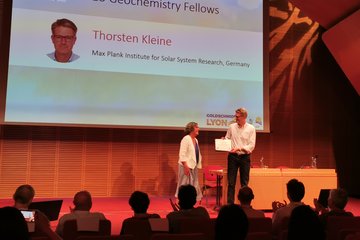Alle Typen
41.
Zeitschriftenartikel
HIFI observations of warm gas in DR21: Shock versus radiative heating. Astronomy and Astrophysics 518, L79 (2010)
42.
Zeitschriftenartikel
The Herschel-SPIRE submillimetre spectrum of Mars. Astronomy and Astrophysics 518, L151 (2010)
43.
Zeitschriftenartikel
Water and related chemistry in the solar system. A guaranteed time key programme for Herschel. Planetary and Space Science 57, S. 1596 - 1606 (2009)
44.
Zeitschriftenartikel
HHSMT observations of the Venusian mesospheric temperature, winds, and CO abundance around the MESSENGER flyby. Planetary and Space Science 56, S. 1688 - 1695 (2008)
45.
Zeitschriftenartikel
Mesospheric vertical thermal structure and winds on Venus from HHSMT CO spectral-line observations. Planetary and Space Science 56, S. 1368 - 1384 (2008)
46.
Zeitschriftenartikel
Middle atmosphere polar warmings on Mars: Simulations and study on the validation with submillimeter observations. Planetary and Space Science 55, S. 1103 - 1112 (2007)
47.
Zeitschriftenartikel
On the winter anomaly of the night-to-day ratio of ozone in the middle to upper mesosphere in middle to high latitudes. Advances in Space Research 40, S. 846 - 854 (2007)
48.
Zeitschriftenartikel
MIRO: Microwave Instrument for Rosetta Orbiter. Space Science Reviews, S. 561 - 597 (2006)
49.
Zeitschriftenartikel
Behaviour of mesospheric ozone under nearly polar night conditions. Advances in Space Research 38, S. 2402 - 2406 (2006)
50.
Zeitschriftenartikel
Validation of stratospheric ClO measurements from the Millimeter-wave Atmospheric Sounder (MAS). Journal Geophysical Research 105 (D7), S. 9053 - 9062 (2000)
51.
Zeitschriftenartikel
MAS-GRAS sensor combination and optimal estimation retrieval of temperature and H2O profiles. Physics and Chemistry of the Earth 25 (8), S. 625 - 628 (2000)
52.
Zeitschriftenartikel
A search for variability in the HCN to H2CO Ratio on Comet Hale-Bopp. Earth, Moon and Planets 78, S. 53 - 61 (1999)
53.
Zeitschriftenartikel
Latitudinal distribution of upper stratospheric ClO as derived from space borne microwave spectroscopy. Geophysical Research Letters 23, S. 2321 - 2324 (1996)
54.
Buchkapitel
Investigations of the Solar Influence on Middle Atmospheric Water Vapour and Ozone During the Last Solar Cycle - Analysis of the MPS Data Set. In: Climate and Weather of the Sun-Earth System (CAWSES) Highlights from a Priority Program, S. 109 - 124 (Hg. Lübken, F.-J.). Springer, Dordrecht (2012)
55.
Buchkapitel
A New, High-performance, Heterodyne Spectrometer for Ground-based Remote Sensing of Mesospheric Water Vapour. In: Advances in Geosciences, S. 569 - 578 (Hg. Bhardwaj, A.; Haider, S. A.; Hartogh, P.; Ip, W.-H.; Ito, T. et al.). World Scientific Publishing Co., Singapore (2010)
56.
Buchkapitel
MIRO: Microwave Instrument for Rosetta Orbiter. In: Rosetta-ESA's Mission to the Origin of the Solar System, S. 291 - 314 (Hg. Schulz, R.; Alexander, C.; Boehnhardt, H.; Glassmeier, K.-H.). Springer Press, Berlin (2009)
57.
Buchkapitel
The Martian Atmosphere as a Submillimeter Flux Calibration Source Using an Opaque Molecular Line: Impacts of Temperature Errors Provided by General Circulation Models. In: Advances in Geosciences, S. 17 - 49 (Hg. Bhardwaj, A.; Hartogh, P.; Kasaba, Y.; Wu, R.; Daisuke, I. et al.). World Scientific, Singapore (2009)
58.
Buchkapitel
The winter anomaly of the night-to-day ratio of ozone in the middle to upper mesosphere in middle latitudes - a comparison between measurements and model calculations. In: Advances in Geosciences, Vol.9: Solid Earth, Ocean Science & Atmospheric Science (2006), S. 177 - 190 (Hg. Ip, W.-H.; Chen, Y.-T.). World Scientific Publishing Company, Singapore (2007)
59.
Konferenzbeitrag
The volatile composition of comet C/2004 Q2 (Machholz) derived from submillimeter observations. In: Highlights of Spanish Astrophysics VII, Proceedings of the X Scientific Meeting of the Spanish Astronomical Society (SEA) (Hg. Guirado, J. C.; Lara, L. M.; Quilis, V.; Gorgas, J.). (2013)
60.
Konferenzbeitrag
Microwave Instrument for the Rosetta Orbiter (MIRO). In: Proceeding of the XXVIIIth General Assembly of URSI, New Dehli, 23.X - 29.X 2005. (2006)











